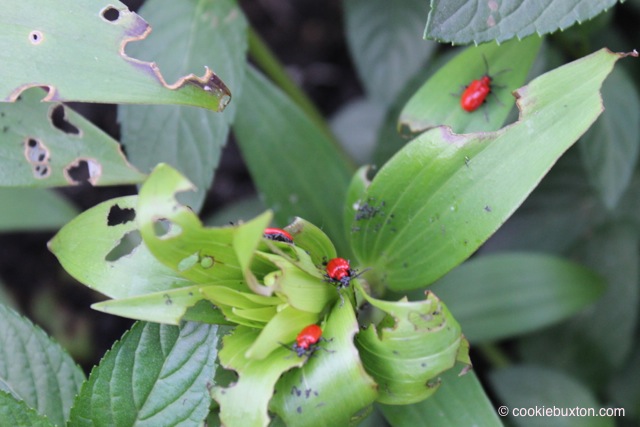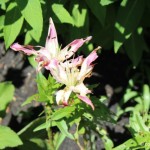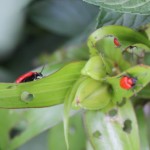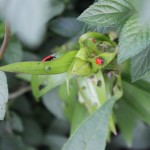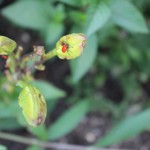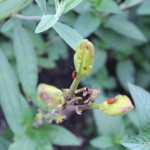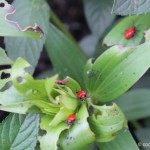Red Lily Beetle
The red lily beetle, also known as the scarlet lily beetle and the lily leaf beetle (Lilioceris lilii), can wreak a lot of damage upon gardeners’ lily collections. The red lily beetle turned up in 2013 in my yard and my neighbour’s yard. Both of our gardens suffered the total devastation of the lilies we had growing in our home gardens. The few Oriental lilies that remain were just barely able survive and to produce flowers these past two years as a result of the beetles stripping the plant leaves and dining as well on the budding flowers. Day lilies are not affected by this beetle.
The lily beetle itself is a rather sturdy looking bug, 6 to 9 mm in length (1/4 to 3/8 inches) with a bright red shell and a black underside. The beetle population became a problem in North America in the 1940s and the beetle has established itself across much of Canada, making its way as far west as Alberta. If you have these bugs in your home garden on your lilies, hostas, and hollyhocks, you will have seen their protective strategy of dropping to the ground belly side up when they sense a threat, making them hard to find. But find them you must so that you can remove them from your plants. I finish the process with the heel of my shoe, but some people prefer to drown the beetles in soapy water. There’s simply no gentle way to kill them. A quick approach is best, in my view.
Battling the red lily beetle is a bit tricky, as evidently it has no natural predators. My commitment to maintaining a garden free of pesticides waivers a little when it comes to getting rid of this beetle, but in fact, had I wanted to spray some type of chemical killer on these bugs, I would be hard put to find something effective. You can check out the literature for yourself if the need arises. I will simply point out that of the chemicals identified for eliminating the beetle, two of them – malathion and carbaryl – are toxic to bees and other beneficial insects (1) and so won’t find a place in my arsenal of insect control methods.
Mechanical control – using real diligence in wiping off the egg packets and hand-picking the red adults – is an effective approach for a small garden, and it worked reasonably well for me this past season. I tried to check the plants daily. Cleaning off the “black debris” on the stems and undersides of the leaves and hand-picking the adults helped control the first generation of the beetle. My plants remained healthy enough to flower, and not so ugly that I felt the urge to dig them out. However, I let my guard down and found a second generation showing up, where I had to again hand pick anywhere from three to four and up to a dozen adults daily from my plants over a period of one to two weeks. At least there weren’t more than this – a single female adult lays about 450 eggs spread out in little egg clusters around the plants. Once the larvae cycle is over, the insects bury themselves in the earth, and then emerge in due course as fully grown adult beetles.
Fortunately, the attractive bright red shells of these beetles make them very easy to see. Within a small garden, with a few lily plants, it is a simple task to pick them off of the plants, and it is not too difficult to locate the beetles that manage to drop and hide. One has, in fact, little choice in the matter. If the beetles have arrived in your garden, you either say goodbye to your lilies, or start your own insect management program. I planted some Fritillaria bulbs this week for a spring showing. It will be interesting to see if I can get keep them beetle-free.
Commercial lily breeders and folks with large lily collections have a much harder challenge than what I face in a small backyard garden. I wish them well in solving the riddle of controlling these pests in a manner that is environmentally friendly.
(1) Wikepedia provides a good starting point for information on the red lily beetle and methods of control.
Photos & Text: NK
Copyright: NK/cookiebuxton.com
Photo location: Home garden
Photo Gallery
Click on any photograph to enlarge. Click on the photo to advance through the photograph series.
